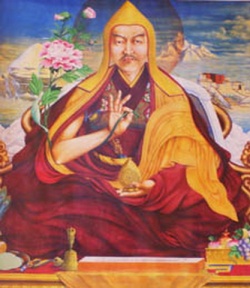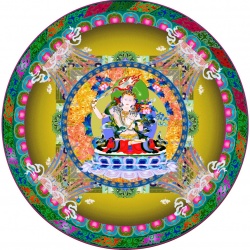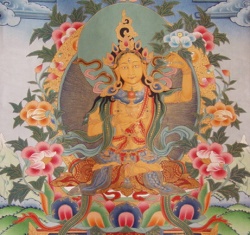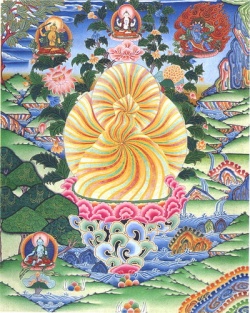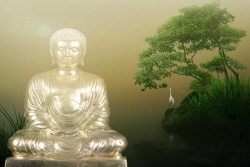Comments on Salient Points in the Sampasadaniya Sutta
by U Ko Lay
1. The need to make known to the world the virtues and attributes of a Buddha.
The appearance of a Buddha is a very rare phenomenon.
Many aeons and many world cycles would pass away without the benefit of a guiding light from an Enlightened Buddha.
A Buddha appears in the world for the sole purpose of showing the true Path to beings enveloped in the gloom, groping in the darkness, of ignorance.
But when a Buddha appears after the lapse of an incalculably long period of time (asankhyeyya), the world is slow and hesitant to take advantage of his appearance, not fully appreciating his virtues and attributes, not realizing his main objective—that of helping beings to escape from rebirth, the endless cycle of suffering.
Thus they take him to be just another samana brahmana, one of those who lead a homeless life of purity, teaching various doctrines of eternalism and annihilism.
When Gotama became a fully Enlightened Buddha, there were already six well-known religious teachers, namely,
Purana,
Kassapa,
Makkhali Gosala,
Ajita Kesakambala,
Pakudha Kaccayana,
Sancaya Belatthaputta and
Nigantha Nataputta,
with their own group of followers, dispensing their own brand of Truth.
Gotama Buddha had to take great pains to show a and prove, through precepts and practice, that, unlike other religious teachers, he was truly the Exalted One, the, Homage-Worthy, the Perfectly Self-Enlightened.
Even as long ago as the time of the Dipankara Buddha, the Bodhisatta, the Future Gotama Buddha, as Hermit Sumedha, had made a firm resolve in three bold declarations "Tinno tareyam, mutto moceyam, buddho bodheyam" which means:
"I will not go alone to the Other Side (i.e. Nibbana),
I will help other beings too to cross to the Other Side;
I will not seek liberation for myself alone,
I will help other beings too to attain liberation;
I will not get enlightened for myself alone,
I will help other beings too to get enlightenment,
to come to know the Four Noble Truths."
After that momentous event, during the following long period of four asankhyeyya and one hundred thousand worlds, as a Bodhisatta he had subjected him self to a rigorous course of training for perfection in ten virtues known as paramis (ten perfected virtues).
(For details, see Comments on the Brahmajala Sutta )
As a result of that training, he attained Buddhahood through Magga Insight.
He became endowed with Sabbannutta Nana and, accruing from it, ten special Nanas which pertain only to the Supremely Self-Enlightened Buddhas.
By virtue of these qualifications, he was in a position then to help other beings to cross to the Other Side and attain liberation, by teaching them the Four Noble Truths.
At the beginning of his Buddhahood, he had to go to great lengths to dispel scepticism and wrong notions about himself, his attainments, his virtues and attributes.
Even the group of Five Bhikkhus who had been his attendants for six years were at first hesitant to accept his word that he had truly become a Supremely Enlightened Buddha, capable of helping them to get liberation if they would listen to his Teaching and practise as he would instruct.
Even when ultimately the five bhikkhus and hundreds of others following them came to accept him as their Teacher and walk along the Path shown by him, they could not fully appreciate and understand all the virtues of a Buddha.
Thus in Brahmajala Sutta of Silakkhandha Vagga, Digha Nikaya, it was pointed out that although Brahmadatta was praising the Buddha, he could do so only in terms of sila which he as a puthujjana grasped and understood.
As such he could not adequately bring forth all the virtues of a Buddha he was not developed enough even to have a glimpse of the Buddha's Sabbannuta Nana which is "profound, hard to see, hard to comprehend, tranquil, noble, surpassing logic, subtle and intelligible only to the Ariyas".
The Buddha therefore took the opportunity to provide, by means of a detailed discourse, a glimpse of certain aspects of the Sabbannuta Nana which had enabled him to see through the sixty-two wrong views prevalent at that time.
In the Sampasadaniya Sutta, the Buddha appeared to be gently chiding the Venerable Sariputta for stating boldly that he had such a firm faith in the virtues of the Buddha, that he believed that there had never been,
there would not be in future, nor there was now any samana or brahmana who could excel the Bhagava in Enlightenment.
But by asking the Venerable Sariputta whether he had the Cetopariya Nana to make such a brave utterance and a definite statement, the Buddha gave him an opportunity to bring out for the benefit of the audience assembled round him the virtues of a Buddha in greater detail to the extent possible for a Chief Disciple to know them.
2. Sariputta's reflection on his own virtues.
On this particular day of the interview with the Buddha the Venerable Sariputta had spent the afternoon immersed in phalasamapatti.
At the time of emergence from it, he directed his mind to reflection on all his virtues of sila, samadhi, and panna up to Savaka Parami Nana.
But he could not fathom the full extent and depth of these 'virtues.
A brief explanation,, is needed with regard to the term Savaka Parami Nana.
Savaka here means an Arahat and Parami Nana denotes knowledge or Insight gained through Parami.
An Arahat is a disciple of the Buddha who has attained the four maggas.
Arahats are of three categories:
the ordinary disciples,
the eighty great disciples and
the two Chief Disciples.
All the three categories of Arahats have completed the full course of the threefold training in sila, samadhi and panna in four ways:
they have realized what is to be realized (Cessation of Dukkha); they have eliminated what is to be eliminated (Tanha, Craving); they have practised what is to be practised (the Noble Path, the Life of Purity); and they have attained what is to be attained (Nibbana).
All of then can enjoy the fruits of Arahatship by entering into phalasamapatti and on emergence from it can exercise paccavekkhana nana, ability to reflect on the attainment gained.
n addition, simultaneously with the attainment of Arahatship, the great disciples and the two Chief Disciples become endowed with
(a) Tevijja—three kinds of nowledge:
Knowledge of Past Existences,
Divine Power-of Sight,
Knowledge resulting in Extinction of Moral Intoxicants;
(b) Chalabhinna, the six kinds of Abhinna (supernormal powers), namely,
Iddhividha nana,
Dibbasota nana,
Cetopariya nana,
Pubbenivasanussati nana,
Dibbacakkhu nana and
Asavakkhaya nana.
(Please refer to Samannaphala Sutta.) Asavakkhaya nana is attained by the ordinary Arahats too, being a manifestation of Arahatship, Arahatta-sadhana; and
(c) Patisambhida, mastery of Analytic Insight.
Thus Savaka Parami nana is of three kinds:
Insight possessed by the ordinary disciples;
insight possessed by the great disciples; and
insight possessed by the two Chief Disciples.
The differentiation arises because of the difference in the period of training in parami each of them had undergone and the emphasis each individual bad placed on certain selected item of the parami.
The ordinary disciples have accumulated their ten paramis for a period of one thousand world cycles only;
the great disciples for one hundred thousand world cycles and the Chief Disciples for one asankhyeyya and one hundred thousand world cycles.
Of the two Chief Disciples, the Venerable Sariputta having greatly specialized in panna parami was far superior to his peer the Venerable Mahamoggallana in intellectual attainments.
A Paccekabuddha is superior to a Chief Disciple because he has attained the four maggas by himself like a Buddha. But unlike a Buddha, he does not possess Sabbannuta Nana and is not capable of teaching the Four Noble Truths.
A Buddha achieves the four maggas and simultaneously becomes endowed with Sabbannuta Nana, which enables him to know all there is to know. He also comes to possess the ten special nanas of a Buddha, which form a part of the Sabbannuta Nana.
(See Comments on Brahmajala Sutta.)
On that particular day, having emerged from phalasamapatti, the Venerable Sariputta by exercising his Savaka Parami Nana went over his past existences, starting from the time of Anomadassi Buddha,
when he made his firm resolution to become a Chief Disciple of a Buddha, to the present moment of entering into phalasamapatti.
He was able to perceive in his mind's eye all the virtues he possessed as regards sila, samadhi and panna. He was however unable to see the full extent and depth of these virtues.
The Venerable Sariputta's survey of the Buddha's virtues.
This set him wondering.
The Savaka Parami Nana he possessed was only a fraction of the Sabbannuta Nana of a Buddha.
But the virtues of his own sila, samadhi and panna were found to be limitless and unfathomable.
How extensive and profound would then be the virtues of sila, samadhi and panna of the Buddha who possessed the Sabbannuta Nana.
He at once endeavoured to survey the event and depth of the virtues of sila, samadhi and panna of a Buddha by going over them in groups of twos, threes, fours, fives, etc., until he arrived at the Mahavajira Nana of the Buddha.
Mahavajira Nana is the vipassana Insight which is developed in between two sessions of phalasamapatti.
It is so powerful and invincible that no opposing force (such as kilesas) can destroy it.
Hence its name Mahavajira Nana — Thunderbolt or Diamon Insight.
It was this Mahavajira Insight which the Buddha employed to penetrate into the full implications of each of the twelve links in the chain of Paticcasamuppada, the law of Dependent Origination.
He repeatedly went over the twelve links in the order of arising and in the order of ceasing of each factor.
In his investigation of the virtues of the Buddha, the Chief Disciple of the Buddha, who was equipped with superior intellect and panna, could fathom these virtues only up to the level of the Mahavajira Nana.
He found his Savaka Pararni Nana, even though it was of the highest rank amongst the disciples of the Buddha, was not adequate to survey the whole extent and depth of the Buddha's Nana.
A disciple of lower grade cannot possibly know the state of mind of a higher disciple; thus even a Chief Disciple is not in a position to know the complete extent and depth of a Buddha's Nana and mind.
Marvelling at the immensity, profundity, and subtlety of the Dhammas set forth by means of this limitless Sabbannuta Nana, the Venerable Sariputta reflected on how he had strongly resolved in the presence of the Anomadassi Buddha to become a Chief Disciple of a Buddha,
how he was fortunate to become now a Chief Disciple of the Gotama Buddha whose Sabbannuta nana was beyond his mental range, whose knowledge of the Dhamma was unfathomable, whose ability to teach the Dhamma was peerless.
A strong surge of admiration for the Sabbannuta nana, and devotional faith and confidence in the virtues of the Buddha welled up in his breast.
The tide of piti (delightful satisfaction) that flushed through him was so overwhelming that he was impelled to proceed to the presence of the Buddha in order to express his fervent faith in and devotion to the Buddha.
When the Venerable Sariputta came out with the bold utterance of unshakable faith in him, the Buddha of course was well aware that the Venerable Sariputta was in no position to know the entire range of the Buddha's mind.
The Sabbannuta Nana of a Buddha is so extensive and deep that another Buddha may spend his whole lifetime praising the extent of his nana to do full justice to it.
But besides a Paccekabuddha or the Buddha, a Chief Disciple is the only individual who can fairly, if not wholly, gauge the extent and depth of the Sabbannuta Nana.
For the benefit of the community of the bhikkhus seated round him, the Buddha gave the Venerable Sariputta the opportunity to express an appreciation of the virtues of the Buddha and his Teaching, to the extent possible with the Savaka Parami Nana of a Chief Disciple.
The contemplative survey of the Dhammas which the Venerable Sariputta had made covered only sixteen categories of the Dhamma taught by the Buddha.
It was in terms of these Dhammas, forming the main body of this Sutta, that the Venerable Sariputta brought forth his eulogy on the virtues and attributes of the Buddha.
To mention only two of these Dhammas: he reflected and contemplated on the Faultless Dhammas, namely, the thirty-seven factors of Enlightenment made up of the Four Methods of Steadfast Mindfulness,
the Four Supreme Efforts, the Four Bases of Psychic Potency, the Five Controlling Faculties, the Five Powers, the Seven Factors of Enlightenment and the Noble Path of Eight Constituents.
He also reflected and contemplated on the Dhamma relating to Classification of the Ayatanas, the six internal Sense Bases and the six external Sense Bases.
The Venerable Sariputta explained to the Buddha that with the knowledge gained by inference from personal experience (Dhammanvaya),
he had arrived at the conclusion that the discovery of these Dhammas belonged exclusively to the domain of the Buddhas and that only a Buddha could know and teach them.
He was fully convinced, therefore, that the Bhagava had truly cultivated the thirty-seven factors of Enlightenment and had fully attained the unsurpassed knowledge of the highest Path and the Supreme Enlightenment.
With this conviction had come his faith in and devotion to the Buddha.
As was expected by the Buddha, the Venerable Sariputta's discourse on the sixteen categories of the Dhamma, in appreciation of the virtues of the Buddha, inspired intense devotional faith and piety in the minds of the assembled bhikkhus to their great benefit.
The Buddha advised the Venerable Sariputta to keep on giving repeatedly this discourse to the bhikkhus, bhikkhunis, to the layman and laywoman disciples in order to dispel any doubt and scepticism about the Tathagata and to promote their welfare.
